Everyone by now knows that Nanyang Technological University of Singapore (NTU) took home the highest LINPACK Award and the Overall Championship from the recently concluded SC17 Student Cluster Competition.
We also already know how the teams did in the Highest LINPACK and Highest HPCG competitions, with Nanyang grabbing bragging rights for both benchmarks.
Now it’s time to dive into the results, see how the other teams did, and figure out what’s what. Let’s walk through the application and task results and see what happened.
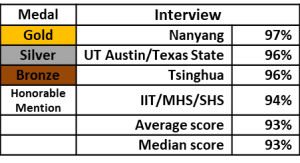 The Interview: All of the teams did pretty well on the interview portion of the competition. This is a pressure packed part of the competition. HPC subject matter experts grill the students on everything from how they configured their cluster to detailed questions about each of the benchmarks and applications. There’s no hiding from their probing questions.
The Interview: All of the teams did pretty well on the interview portion of the competition. This is a pressure packed part of the competition. HPC subject matter experts grill the students on everything from how they configured their cluster to detailed questions about each of the benchmarks and applications. There’s no hiding from their probing questions.
Nanyang had the highest interview score, notching an almost perfect 97%, but they were closely followed by Team Texas and Tsinghua, who tied for second with 96%.
Team Chicago Fusion (IIT/MHS/SHS) deserves an honorable mention for only being 3% off the winning mark on the interview portion of the scoring.
All of the teams did well in this area, as you can tell by the average/median score of 93%.
The ‘mystery application’ is an app that students only learn about when they’re at the competition. There’s no preparing for it, it’s like suddenly being told in a basketball game that for one quarter, the hoop height will be increased to 15 feet or decreased to five.
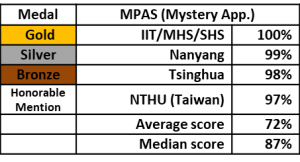 The mystery app for 2017 is MPAS A, an application developed Los Alamos National Lab and the National Center for Atmospheric Research to build weather simulations. Students were given the task of modeling what would happen to the rest of the atmosphere if excess carbon was sequestered in Antarctica.
The mystery app for 2017 is MPAS A, an application developed Los Alamos National Lab and the National Center for Atmospheric Research to build weather simulations. Students were given the task of modeling what would happen to the rest of the atmosphere if excess carbon was sequestered in Antarctica.
This is Team Chicago Fusion’s best application – they nailed it and left it for dead with a score of 100%. Nanyang almost scored the bullseye with a score of 99% and Tsinghua was an eyelash behind, posting a score of 98%. NTHU finished just out of the money with a 97% score.
As you can see by the high median score, most of the teams were bunched up on the good side of the average – meaning that most teams scored well on this application with a few outliers on the low low side.
The next task up is the Reproducibility exercise. This is where the teams take a paper that was submitted for SC16 and try to reproduce the results – either proving the paper is valid, or…well, not so valid.
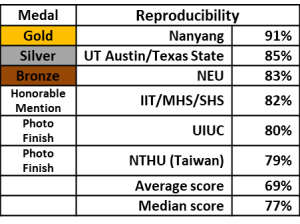 The paper this year has an intriguing title, “The Vectorization of the Tersoff Multi-Body Potential: An Exercise in Performance Portability”, and shows how to use a vectorization scheme to achieve high cross-platform (CPU and accelerator) performance.
The paper this year has an intriguing title, “The Vectorization of the Tersoff Multi-Body Potential: An Exercise in Performance Portability”, and shows how to use a vectorization scheme to achieve high cross-platform (CPU and accelerator) performance.
Student teams have to use the artifact section of the paper to reproduce the results and either prove or disprove the paper, then submit a report detailing and justifying how they arrived at their conclusion.
Nanyang posted another win, building on their lead over the rest of the pack. Team Texas took home second place, only six points behind Nanyang. NEU finds the winner board for the first time in the competition with their third place showing.
Team Chicago Fusion gets an Honorable Mention for their score of 82%, just a couple of points away from second and third place, while Team Illinois Urbana-Champaign and Taiwan’s NTHU finish in a virtual tie at 80% and 79% (and some change) separating them.
The rest of the teams had at least some trouble with this task as witnessed by the median being significantly higher than the mean score. This indicates that there are several teams who encountered difficulties completing this task. But, hey, who said this was going to be easy?
Speaking of things that are difficult, how about that MrBayes? This year, the students were using MrBayes to examine how viruses transmitted by white flies are impacting cassava production in Africa.
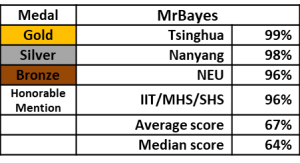 This wasn’t an easy application for most of the teams. While Tsinghua pulled down a 99% score, closely trailed by Nanyang with 98%, the average score on this app was only 67% and the median was 64%.
This wasn’t an easy application for most of the teams. While Tsinghua pulled down a 99% score, closely trailed by Nanyang with 98%, the average score on this app was only 67% and the median was 64%.
This was a great app for NEU, however, with their 96% score putting them in the winners circle. Team Chicago Fusion was just a few fractions of a point behind NEU, nabbing the Honorable Mention.
The most difficult application in this edition of the cluster competition looks to be Born, a seismic imaging app used to identify oil and gas reserves. It’s not that this was necessarily the most complicated or difficult to understand application, it’s that it was so damned time consuming. And it’s the time consuming nature of Born that separated the teams in the final accounting.
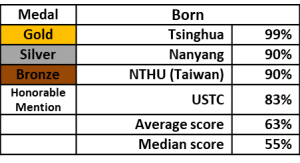 The teams had to try to process 1,136 Born “shots.” Each shot is independent of the others, which makes for an embarrassingly parallel application – great, right? Well, no. Running on CPUs alone, each Born shot takes somewhere between two and three hours. Ouch.
The teams had to try to process 1,136 Born “shots.” Each shot is independent of the others, which makes for an embarrassingly parallel application – great, right? Well, no. Running on CPUs alone, each Born shot takes somewhere between two and three hours. Ouch.
Several of the teams decided to use their cloud budget and run a bunch of Born instances in the cloud. While this was a good idea, the teams didn’t have enough cloud capacity to run all that much Born – particularly since each shot took so long to complete.
The best approach was to port Born onto GPUs, as four or five teams proved. The top teams on our leaderboard all ported Born and realized great dividends. Tsinghua completed the entire 1,136 slate of datasets and posted a score of 99%. Nanyang also completed all of the datasets and took home second place with their score of 90%. NTHU was a nanometer behind and grabbed third place. USTC gets an honorable mention for posting a score of 83%.
The rest of the teams didn’t do so hot on this one. The average score was competition low of 63% with the median score at 55%. This was a tough mountain to climb and if you didn’t port Born over to GPUs, you didn’t have a chance to complete all of the datasets, even if you were able to devote your entire cluster to it.
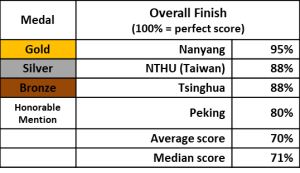 Looking at the final stats, Nanyang was the clear winner with an astounding 95 out of a possible 100 points. NTHU and Tsinghua finished very close together, with NTHU nabbing second place by fractions of a percent. Team Peking, a relative newbie with this being their second appearance in the competition, takes home an honorable mention.
Looking at the final stats, Nanyang was the clear winner with an astounding 95 out of a possible 100 points. NTHU and Tsinghua finished very close together, with NTHU nabbing second place by fractions of a percent. Team Peking, a relative newbie with this being their second appearance in the competition, takes home an honorable mention.
These teams finished above the rest of the pack by a respectable margin, as shown by the average score of 70% and the median score of 71%. But, at the end of the day, all of the teams were winners. Everyone showed up, no one gave up, and everyone learned a lot (including me, in fact).
So that’s another student cluster competition in the books. If you’ve missed any of our coverage, you can catch up on it visiting our Student Cluster Competition omnibus site.
One final note: the bettors in our betting pool were woefully uninformed. The ‘smart money’ was pretty dumb this year, given that the winning Nanyang team was placed as a 35-1 underdog. Wow, if this was a real pool, anyone betting on Nanyang would have really cleaned up!
We’ll be back with more Student Cluster Competition features, more competitions, and even better coverage in 2018. Stay tuned.
Posted In: Latest News, SC 2017 Denver
Tagged: Results
